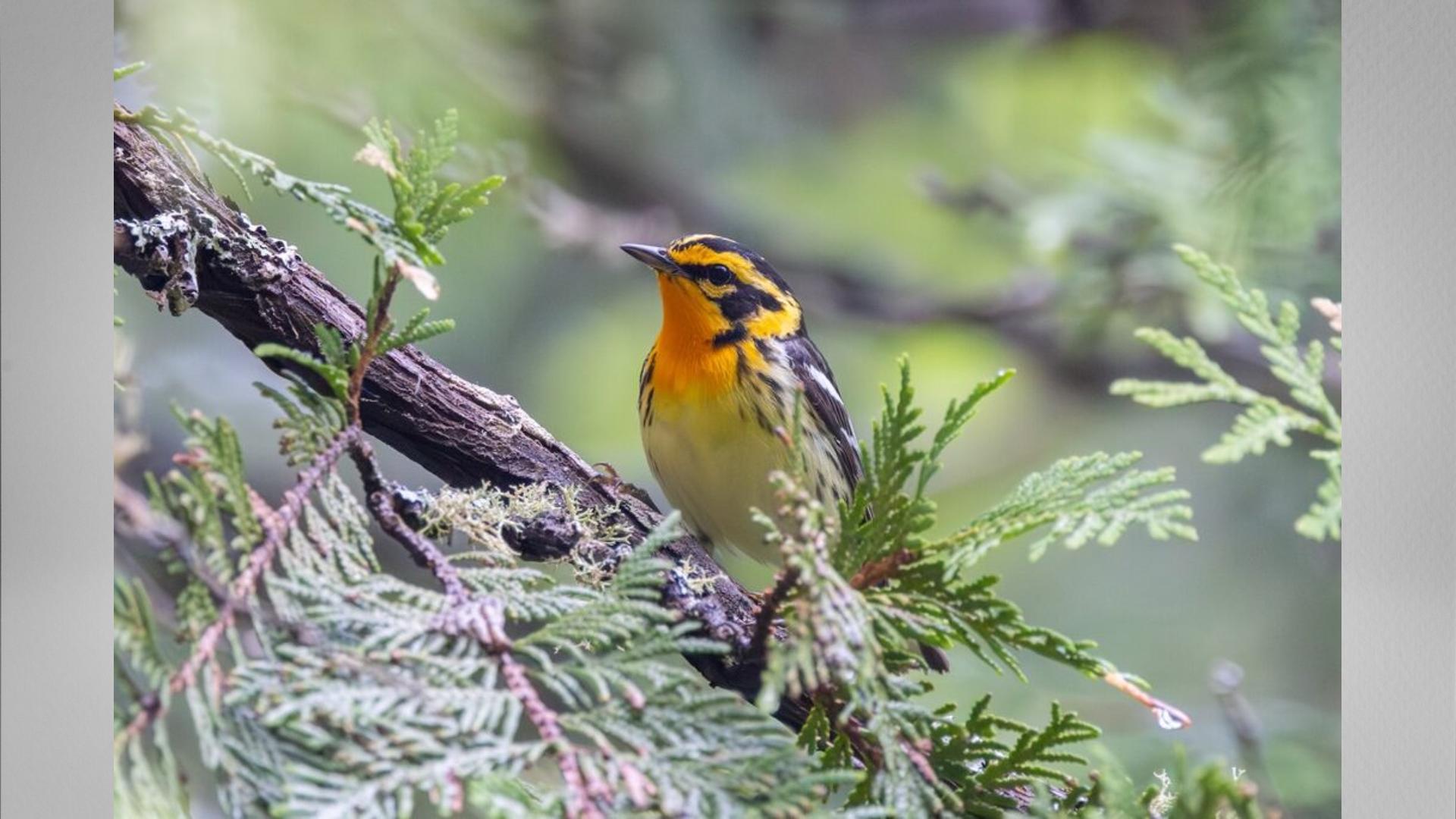Scroll For More

Score (94)
The Surprising Risk Songbirds Take for a Genetic Jackpot
Songbirds embarking on their epic journeys from northern boreal forests to tropical winter havens may gain more than just warmth—they might also enjoy greater genetic diversity. A University of Michigan study reveals that these long-distance migratory birds boast higher genetic diversity compared to their less adventurous counterparts who stay closer to home. Lead author Benjamin Winger, an associate professor at U-M, explains, "Long distance migration has evolved to be a very successful strategy for birds because even though it's difficult and requires extraordinary physiology, it allows them to spend the northern winter in a place where they enjoy a higher survival rate." The research team examined the genomes of 35 bird species, including hermit thrushes and Swainson's thrushes. They discovered that while some species exhibit extensive gene flow across populations, others maintain distinct genetic patterns tied to specific breeding locations within the boreal forest. First author Teresa Pegan was surprised by the findings: "I almost fell out of my chair when I found it—there's actually a really remarkably strong relationship between migration distance and the amount of genetic diversity in the population." These insights are crucial for conservation efforts as climate change and human activities threaten bird habitats. Winger notes that deforestation poses significant risks: "We're showing that some species probably have a lot of gene flow... But others really come back to the same patch of forest every year, and those might be more susceptible to deforestation." This study highlights how understanding migratory patterns can aid in protecting these resilient travelers as they navigate an ever-changing world.

Score (98)
Danièle Sauvageau Makes History as First Woman Builder in Hockey Hall of Fame
Danièle Sauvageau, a pioneering force in Canadian hockey, is set to make history as the first woman ever inducted into the Hockey Hall of Fame as a Builder — a category reserved for individuals whose off-ice contributions have shaped the game. Sauvageau's influence stretches across every level of hockey, from grassroots to Olympic gold, and her induction marks a milestone decades in the making. Her path from a girl in Deux-Montagnes, Quebec — once barred from playing organized hockey because she wasn’t a boy — to one of the sport’s most respected minds is nothing short of transformational. “She’s touched every level of female hockey — and male hockey, to be honest,” said Marie-Philip Poulin, captain of the Montreal Victoire and a longtime protégé. “She’s always had a strong drive to make sure that we grew female hockey here in Quebec. And for many years, it was difficult.” Now, with the success of the PWHL and the Victoire drawing thousands of fans, Poulin says Sauvageau’s vision has taken root. “It’s pretty incredible.” A Builder in Every Sense There are 119 Builders in the Hockey Hall of Fame, including names like Scotty Bowman, Pat Burns, Gary Bettman, and Lord Stanley. Until now, not one was a woman. Sauvageau’s resume, however, left little room for debate. She led Canada’s women’s national team to Olympic gold in 2002 — the country's first hockey gold in 50 years. She was the first woman to coach in the QMJHL. She founded the Université de Montréal women’s hockey program in 2008. She’s worked as an NHL analyst, an Olympic consultant, and the general manager of the PWHL’s Montreal Victoire. And she did it all while working full-time for over three decades as a decorated police officer. “She’s intimidating,” Poulin admitted with a smile. “But she has a soft inside. And that’s something that’s quite a privilege when you get to know her.” A Relentless Advocate Though Sauvageau was never allowed to play in boys’ leagues as a child, she never stopped carving out space for women in the game. From coaching and development to facilities and media, she opened doors that had long been locked shut. “I used to say, ‘I’m not at the right place at the right moment,’” she said, reflecting on a career filled with barriers. “But every time, I was able to just put my foot in … and today, I feel like I was just there at the right time to help.” Her legacy includes not just medals and job titles, but real infrastructure. Most notably, she created Centre 21.02 — a dedicated training facility for elite female hockey players, born in the wake of the CWHL’s collapse. Named after the date of Canada’s gold medal win in Salt Lake City, the centre now draws athletes from around the world. “She created that place for them to be,” said Caroline Ouellette, four-time Olympian and assistant coach of the Victoire. “Now everyone knows how incredible it is.” A Full-Time Role, At Last Until the PWHL launched in 2023, Sauvageau’s hockey leadership was essentially volunteer. She had full-time duties in law enforcement, including work on some of the country’s most traumatic cases: the 1989 École Polytechnique shooting and the 2006 Dawson College attack. Her experience in policing shaped her leadership: structured, composed, and tactical — but always team-oriented. “You don’t know when things are going to happen,” she said. “Are you going to be alone? No, not alone.” That mindset has carried over into her work with Victoire. “She’s not leading alone,” said Kim St-Pierre, former Team Canada goaltender and now the Victoire’s head of business operations. “You can see that everyone has her back and wants to compete and show up for her.” PWHL: A Dream Realized When women’s professional hockey found new life with the PWHL, Sauvageau was immediately at the centre of it. She was named the first general manager of the Montreal Victoire and helped lead the team through a breakout inaugural season — one that included a sold-out 21,000-seat Bell Centre and a surge in young girls registering for hockey. “She knew from day one when that league was going to be created, she was going to be involved,” Poulin said. “It’s no surprise.” Now, just two years after the league’s formation, the PWHL is shattering records — in attendance, sponsorship, and visibility. For Sauvageau, it’s a culmination of 40 years of belief and work. “Even if I’ve been in the game for 40 years, I knew that it could work,” she said. “But as fast as that? It’s unbelievable.” Still Building With women’s hockey now surging in popularity, Sauvageau isn’t stepping back. She’s pushing for more — more rinks, more ice time, more women in coaching roles, and more opportunities for kids to discover hockey like she once did at the outdoor rink in Deux-Montagnes. “She’s opened so many doors,” said St-Pierre. “And Danielle is not done.” Sauvageau says she often asks herself whether she can still contribute — and the answer, so far, is always yes. “Until I can’t,” she said, “there’ll always be that fire to continue.”

Score (97)
She Launched a Mobile Bookstore, The Thirsty Reader, Bringing Books and Brews Together
As a kid, Becky Davison spent countless hours scouring the shelves of Woozles bookstore in Halifax, armed with $10 from her parents and a love of reading that would never leave her. Now, that childhood joy has become her business model. Davison is the founder of The Thirsty Reader, a mobile bookstore that pops up in pubs and bars across Nova Scotia. Think local brews and local books — all in one stop. “This summer I was working on a project and it failed, and I needed a new project that I’m excited about,” Davison said. “I wanted to start something new. It could be a pop-up.” That idea turned into a bookstore on wheels, complete with novels, biographies, and self-help titles — many of which Davison has personally read. Her first event was at Good Robot, a Halifax brewery known for hosting silent reading nights. “They took a chance on me,” she said, “and let me host my first event.” Since launching in late September, the response has been fast and encouraging. “I’m very impressed with the people who have come out,” Davison said. “People want an excuse to come out. It’s not a networking event. You’re coming out to a pub to have a pint. You get to talk about books.” Her pop-ups feel more like a casual hangout than a bookstore. Patrons flip through titles with a drink in hand and strike up spontaneous conversations about what they’ve read or what they’re looking for next. “There’s a big resurgence of physical books,” Davison said. “There are a lot of people on social media talking about books. It’s good to see bookstores thriving and surviving.” At every stop, she highlights authors from Atlantic Canada, including Lesley Crewe, Jane Doucet, Jessica Ilse, Susan LeBlanc, Michelle Hebert, Matt Thomson, and Keonte Beals. “I predominantly have fiction,” she said. “I have some biographies, some self-help. Predominantly the books I’m showing are books I’ve read.” Her project has already taken her across Halifax and as far as Grand Manan, New Brunswick. With more events lined up through December — including stops at vineyards and cozy pubs — Davison is just getting started. The irony, she admits, is that running a bookstore hasn’t left her much time to actually read. But she’s not complaining. “For me, it’s fun because I get to go to new places, have a pint, read books and meet people,” she said. Looking ahead, Davison hopes to expand The Thirsty Reader into places like Moncton and Cape Breton, and start supplying reading groups as well. For now, she’s happy to bring together strangers over stories — the kind you drink, and the kind you can’t put down.

Score (97)
28 Royal Marine Veterans March 925 Miles Across the UK for Charity — While Carrying 20-Pound Packs
Twenty-eight former Royal Marines have completed a gruelling 925-mile (1,490 km) speed march from John O’Groats to Land’s End, raising thousands for charity and reigniting the bond forged during their years in service. Known as the Bootneck Yomp, the challenge saw the group march the length of mainland Britain in just eight days, finishing on Saturday in Cornwall after setting off from Scotland’s northern tip on October 31. Each participant carried a 20-pound (9kg) pack and completed at least a marathon distance per day — a punishing physical test that reflected the toughness of their Commando days. Organiser Mark Gordon said the experience was about more than fundraising. “We've recaptured this magic of bond in service life, especially Royal Marine commando life,” he said. “Already, people are asking what's the next one.” The effort raised money for several charities, including Combat Stress, the Royal Marines Charity, Papyrus, Alzheimer’s Society, and Cancer Research UK. The final total is still being counted, but organisers said donations have already reached into the thousands. Penzance firefighter Adam Harvey, one of the marchers and a former Royal Marine, said taking part was deeply personal. “It’s a massive achievement, I feel proud,” he said. “The feeling of being back with a group of ex-Royal Marines is really special.” Gordon, who helped plan the event over several months, said it brought lasting impact beyond the money raised. “During the intense training, organisation and planning over the past months, we’ve rediscovered shared bonds and it’s really made a positive difference to us all,” he said. “As a team where the average age is 49, we’re keen on proving that it’s still a state of mind.” The march covered iconic terrain and demanded an elite level of endurance — something many might not expect from a group largely made up of men in their 40s and 50s. But for these former commandos, it was a return to form. And by the end of their journey at Land’s End, they had done more than complete a challenge. They had honoured their service, raised money for good causes, and reminded others — and perhaps themselves — of the strength of their shared identity.

Score (97)
Rockefeller Center Christmas Tree Arrives In New York City To Usher In Holidays
The holidays have officially kicked off in New York City with the arrival of the Rockefeller Center Christmas tree — a 75-foot Norway spruce that made the 150-kilometre journey from East Greenbush to Manhattan over the weekend. The towering tree was donated by Judy Russ, whose family has watched it grow for decades in the Albany suburb. Seeing it finally installed in one of the most iconic holiday locations in the world was emotional. "Finally seeing the tree that's been in my family forever in Rock Center is just incredible," Russ said. "It is an overwhelming feeling of joy, pride. We feel very humble. It's just a full culmination of everything that has happened so far. It's finally happening and we're thrilled." Crews used a crane to lift the 11-ton tree from its flatbed truck and guide it into position at 30 Rockefeller Plaza, between 49th and 50th streets. It took several hours to secure the massive spruce in place. Over the coming weeks, the tree will be decorated with more than 50,000 multicoloured LED lights and topped with a Swarovski crystal star. The official lighting ceremony is scheduled for December 3 and will be broadcast nationally, as it has been for decades. After its time in the spotlight, the tree will be taken down in mid-January. It won’t go to waste — organizers say it will be milled into lumber and donated to Habitat for Humanity to help build affordable housing. This year’s spruce stands slightly taller than last year’s, which was a 74-foot tree from West Stockbridge, Massachusetts — the first from that state since 1959. The Rockefeller tree tradition dates back to 1931, when construction workers building Rockefeller Center pooled money to buy a small tree during the Great Depression. Their families decorated it with handmade garlands. The first official tree lighting took place in 1933, and the event has grown into a cherished New York City tradition ever since. For visitors and locals alike, the arrival of the Rockefeller tree marks the unofficial start of the holiday season — and the countdown to one of the city’s most anticipated celebrations.

Score (98)
Teen Freestyle Football Champion Shines in New Guinness World Records Book
Isabel Wilkins isn’t just a rising star in freestyle football — she’s already carved out her name in history. The 18-year-old from Bradford-on-Avon, Wiltshire, has landed a spot in the Guinness World Records: Football Edition 2026, the first-ever book dedicated entirely to the top 100 football achievements worldwide. Wilkins, a two-time freestyle football world champion, doesn’t just appear in the book — she wrote the foreword. In it, she encourages fans to try breaking records themselves and shares step-by-step tips for mastering freestyle moves. At just 18, she already holds four official Guinness World Records. Even more impressively, she earned them all on the same day — January 8, 2024 — and on her first attempt each time. Her titles include: • Most "Abbas around the world" tricks in 30 seconds • Most "hop the world" tricks in 30 seconds • Most "clipper" tricks in one minute • Most "half beck around the world" tricks in one minute Freestyle football is a sport rooted in creativity and control, with athletes performing intricate tricks using all parts of the body — head, shoulders, feet, and everything in between — to juggle a ball with style. “The past few years have been incredible,” Wilkins said. “It’s been amazing, what freestyling has given me. It’s pretty crazy to think.” She first stunned the freestyle world in August 2023 when, at just 15, she became the youngest female freestyle football world champion in history, winning the Super Ball World Open in Prague. She successfully defended her title the following year in Liberec, Czech Republic. Wilkins is currently training in the Netherlands alongside the men’s world champion, as she prepares to compete again at the World Freestyle Football Championship in Sopot, Poland, on December 13. “I’m hoping for the world championship title again but it will be hard, the level is increasing year after year,” she said. “I’m going to give it my best shot.” She says the growth of the sport — especially for women — has been exciting to witness. “Last year at the world championships there was a record number of female participants, so it’s definitely increasing a lot which is really great to see.” Wilkins hopes her story will help bring more young people into freestyle football, especially girls. “I’m trying to inspire as many young people, especially young girls, to show them that football and freestyle can be something amazing.”

Score (97)
Want Better Sleep? More Fruits and Veggies Might Help — Starting Tonight
A new study suggests that loading up on fruits and vegetables could lead to better sleep — and the benefits might kick in almost immediately. Researchers from Columbia University and the University of Chicago tracked 34 healthy young adults over 201 days, examining how diet influenced sleep quality. Their findings, published in Sleep Health, revealed that participants who ate around five cups of fruits and vegetables daily slept up to 16% more soundly. “Sixteen percent is a highly significant difference,” said Dr. Esra Tasali, co-senior author and director of the UChicago Sleep Center. “It’s remarkable that such a meaningful change could be observed within less than 24 hours.” Participants used a food-logging app to record their meals and wore wrist monitors to track their sleep. These devices measured how often they woke up and how well they transitioned between light and deep sleep throughout the night. The results hint at a surprisingly fast payoff from eating more produce. Tasali believes this makes dietary changes an accessible tool for anyone looking to improve sleep without medication. “Dietary changes may offer an accessible way to improve sleep quality,” she said. One possible reason is biochemical. The researchers say fruits and vegetables contain carbohydrates and nutrients that help the brain absorb tryptophan — an amino acid that increases levels of melatonin, the hormone that regulates sleep. Other experts say there may be an additional benefit: blood sugar stability. “Fruits and vegetables are low glycemic, which means they help stabilize blood sugar levels,” said Autumn Bates, a California-based clinical nutritionist, in an interview with Fox News Digital. “Unstable blood sugar levels cause cortisol to spike while we sleep, which in turn wakes us up.” Bates wasn’t involved in the study, but she agrees with its overall message. “Small changes can impact sleep,” she said. Marie-Pierre St-Onge, a professor of nutritional medicine at Columbia and co-leader of the study, said the findings empower people to take simple actions that may improve their rest. “People are always asking me if there are things they can eat that will help them sleep better,” she said. “Small changes can impact sleep. That is empowering — better rest is in your control.” The study also emphasized that reaching the CDC’s recommended five cups of produce a day doesn’t have to be complicated. For fruit, a single medium apple, pear, peach, or orange counts as one cup. So do 22 grapes. For vegetables, it takes about 12 baby carrots or two regular carrots to hit the one-cup mark. Cooked greens like spinach shrink considerably, so two cups raw equals one cup cooked. A large ear of corn or a medium potato also meet the one-cup threshold. While the results are promising, experts say more research is needed. Carolyn Ievers-Landis, a clinical psychologist and professor at Case Western Reserve University who was not involved in the research, pointed out that the study wasn’t a controlled experiment and didn’t prove cause and effect. “There is a high likelihood that these individuals are healthier overall — that they get more physical activity, they might drink less alcohol and they might spend more time in natural sunlight,” she said. “Still, it’s always a good idea to eat a healthy diet and engage in healthier behaviors to optimize sleep.” The researchers say they plan to dig deeper into the biological mechanisms behind the findings and test them in more diverse populations. But for now, they believe there’s enough evidence to encourage people to make fruits, vegetables, and whole grains a daily habit. And if a few extra grapes or carrots help you get a better night’s sleep? All the better.

Score (97)
Researchers Discover DNA's Role in Eco-Friendly Drug Development
Scientists at the National University of Singapore have discovered a surprising new use for DNA — not as a genetic blueprint, but as a tool to guide the creation of safer, more effective medicines. In a study published in Nature Catalysis, the research team, led by Assistant Professor Zhu Ru-Yi, showed that specific parts of DNA known as phosphate groups can act like tiny chemical “hands,” steering molecules during a reaction to ensure the right version of a drug is made. That precision could significantly improve the way pharmaceutical compounds are produced. Many drugs exist in two mirror-image forms, or chiral versions — like a left and right hand. But while one version may effectively treat disease, the other might do nothing, or worse, cause harm. Making only the “right-handed” version has long been one of drug development’s biggest headaches. The new DNA-guided method offers a potential shortcut: it’s cleaner, simpler, and could be more environmentally friendly than conventional techniques. A New Role for DNA DNA is best known for storing genetic information. But in this case, researchers discovered it can also help direct chemical reactions. That’s because DNA’s phosphate groups are negatively charged, and they naturally attract positively charged amino acids — a common interaction inside living cells. Zhu’s team wondered whether that same attraction, called ion pairing, could be harnessed in the lab to guide the way molecules react. Their hunch paid off. The team showed that DNA’s phosphate groups could pull in and hold charged molecules in exactly the right alignment to produce a single, desired mirror-image compound — no messy leftovers, no unwanted byproducts. “Nature never uses DNA phosphates as catalysts, but we have shown that if designed properly, they can act like artificial enzymes,” Zhu said. A New Method: PS Scanning To figure out which parts of the DNA strand were actually responsible, the team invented a technique called PS scanning. It allowed them to swap out individual phosphate sites with chemically similar substitutes. If replacing a phosphate disrupted the reaction’s precision, it meant that site had been playing an important role. To back up the lab work, the team collaborated with Professor Zhang Xinglong at The Chinese University of Hong Kong, who ran computer simulations that confirmed the phosphate groups were key to driving the reaction. Implications for Drug Manufacturing This discovery could change how we make chiral drugs — a class that includes everything from antidepressants to cancer treatments. Traditional methods for separating mirror-image compounds are often slow, costly, and environmentally taxing. The DNA-based method offers a new route that’s fast, efficient, and doesn’t rely on heavy metals or toxic solvents. “It’s a cleaner way to get the compound you want, without a lot of waste,” Zhu said. Because DNA is inexpensive, widely available, and easily modified, it also opens the door for customizable, lab-made versions that can act like synthetic enzymes — without the complexity of designing a whole new molecule from scratch. What’s Next The team now plans to keep experimenting with DNA phosphates to create new kinds of chiral compounds, with a focus on next-generation medicines. The approach could become a powerful tool in green chemistry, where the goal is to reduce waste and energy use in industrial processes. For Zhu and his colleagues, the appeal is both scientific and practical. “We’re not reinventing DNA,” he said. “We’re just giving it a new job.” And if it works, the most iconic molecule in biology might soon be just as essential in the chemistry lab.

Score (98)
Recycling Worker Reunites Lost WWI Medal With Soldier's Son After 55 Years
A First World War medal that was nearly lost to a pile of scrap metal has found its way home — and just in time for Remembrance Sunday. The Victory Medal, awarded to Private Willie Greaves of the West Yorkshire Regiment, disappeared after his death in 1970. More than half a century later, it has been returned to his son Jeff Greaves, a 98-year-old Royal Navy veteran of World War Two. “This medal will eventually go to my son,” said Mr Greaves, who plans to wear it for the first time at Sunday’s service in Pudsey, Leeds. “He’s quite family orientated so I know he will look after it. It’s going to stay with us for a very long time.” The medal’s journey back to the family began at a Bradford recycling centre, where David Steinberg, the general manager and a former South African Navy seaman, noticed a small collection of coins and medals that had fallen from an electromagnet. “I collected them up, threw them in a box and forgot about them,” Steinberg recalled. Later, spotting the World War One medal engraved with the name “W GREAVES,” he decided it couldn’t just sit in a pile. “I told my mate Tommy, ‘We have to find somebody that we can give this medal to. I want this to go to the family.’” Steinberg handed the medal to Tommy Flynn, a founder of the Dog & Gun Wibsey Veterans Group. From there, the search to uncover its story began. Using the engraved name, rank, and serial number, local historians from the Bus to Bradford group traced the medal to Private Willie Greaves, who served with the Leeds Rifles, a battalion of the West Yorkshire Regiment. He was wounded during the Second Battle of Bullecourt in France and discharged in 1917. Shrapnel lodged in his foot would trouble him for the rest of his life. The next link in the chain came through Damon Sugden, president of the Pudsey and Farsley branch of the Royal British Legion. He placed a notice in a community magazine, the Pudsey Squeaker, seeking any living relatives. To his surprise, he received a phone call: someone believed Willie was the father of Jeff Greaves — a man Sugden had already met through local civic work. “We just couldn’t believe it,” Sugden said. “It was just one of those moments of fate where everything comes together.” The handover took place at the Dog & Gun pub in Wibsey, with a guard of honour from local veterans standing by. Mr Greaves was visibly moved by the unexpected return of his father’s long-lost medal. “Jeff was very touched and completely flabbergasted that this medal has turned up after all of these years,” said Steinberg. “It’s quite a story — it’s a good news story, for once.”

Score (98)
This UK Town Just Unveiled a Sculpture Honoring a Heroic Parachuting War Dog, Bing
When a family in wartime England could no longer feed their pet dog due to rationing, they handed him over to the army. That simple act led to an extraordinary chapter in military history. The dog, an Alsatian-collie mix named Bing — originally Brian — was trained as a war dog and went on to parachute into Nazi-occupied Europe during World War Two. This week, the people of Loughborough, Leicestershire, paid tribute to him with a newly unveiled metal sculpture in Queen’s Park, just in time for Remembrance Sunday. Installed near the Carillon Tower, the statue sits beside a wire mesh sculpture of a war horse named Songster, which was unveiled in 2018. Bing’s addition marks another nod to the often-overlooked animals that served alongside soldiers in wartime. David Northage, the Mayor of Charnwood, called Bing’s story “truly remarkable” and said it was a reminder of the town’s rich military heritage. “Bing is part of that, along with all the other animals that helped servicemen and women during the Second World War,” he said. “I am pleased that Bing has been installed in front of the Carillon Tower ahead of Sunday’s Remembrance service.” Bing was awarded the PDSA Dickin Medal in 1947, the highest award for animal bravery — often described as the animal equivalent of the Victoria Cross. His wartime service began after the Fetch family from Loughborough donated him to the military in 1944, no longer able to keep him due to food shortages. He trained at the Army War Dog Training School in Hertfordshire before joining the 13th Parachute Battalion, part of the 6th Airborne Division. His first combat jump was into the town of Ranville, Normandy, on D-Day in June 1944. The operation did not go smoothly. According to the PDSA, Bing became stuck in a tree and had to be cut down under enemy fire by his handler, Sgt Ken Bailey. The pair went on to serve together for months as Allied forces advanced toward Berlin. Despite sustaining minor injuries, Bing continued his work as a sniffer and sentry dog. In March 1945, he made his final jump during Operation Varsity and Operation Plunder — part of the Allied push across the Rhine into Germany. All told, Bing parachuted into combat seven times. After the war, Bing returned home to the Fetch family, where he lived out his days. He died in 1955 and was buried with other Dickin Medal recipients at the PDSA Animal Cemetery in Ilford, Essex. The new sculpture was designed and built by artist Duncan Thurlby as part of a project led by Loughborough in Bloom, with support from Charnwood Borough Council and its waste and recycling partner, Serco. Pat Cook, chair of Loughborough in Bloom, said the group had long been looking for ways to honour the town’s military connections. “We wanted to recognise Bing for the amazing work he did during the Second World War and his fascinating story,” she said. While many Remembrance events focus on soldiers who served, the addition of Bing’s statue is a reminder of the vital roles animals played in war — from carrying messages to detecting danger — and the risks they shared alongside human troops.

Score (98)
Dodgers Fans Flood Toronto Children’s Hospital With Donations After World Series Win
The Los Angeles Dodgers may have broken Toronto hearts with their dramatic World Series win, but their fans have turned the sting into something unexpected — kindness. In a show of unexpected sportsmanship, Dodgers fans have donated over $30,000 to Toronto’s Hospital for Sick Children (SickKids), transforming a fierce championship rivalry into a cross-border act of compassion. The wave of generosity began with a simple idea. After the Dodgers beat the Toronto Blue Jays in Game 7 to claim back-to-back titles, Jays fan Marcus Kim took to Reddit’s r/baseball community with a suggestion: the winning team’s supporters should donate to the losing city’s children’s hospital. “Let’s offset the negativity generated by gamblers and enjoy the ride,” Kim wrote, referencing the online hostility and betting backlash that often follows major sporting events. He then posted a $60 donation receipt to Children’s Hospital Los Angeles — the Blue Jays’ traditional pick when they win — and encouraged Dodgers fans to pay it forward in Toronto. The response was immediate. Hundreds of Dodgers fans followed through, directing their money to SickKids and sharing receipts and messages of support. “Sending love from Los Angeles,” one donor wrote. Another added: “In the name of Alex Vesia. We are rivals, not enemies. Good health to you and yours. Go Dodgers.” SickKids confirmed they received more than 400 donations from U.S.-based contributors, many with direct references to the Blue Jays, baseball, or even specific players. “It has been a sweet surprise to see these U.S. donations come in,” said Sandra Chiovitti, director of public relations at SickKids. “So many reasons for us to smile after some tears last Saturday night.” Some Dodgers fans donated symbolic amounts — $51, a nod to relief pitcher Alex Vesia, who stepped away from the series citing “deeply personal family matters.” The Blue Jays wore the number 51 on their hats during the series in solidarity. Vesia later revealed he was grieving the loss of his baby daughter. The outpouring of support now marks a growing tradition. Just weeks earlier, after Toronto beat Seattle in the American League Championship, Jays fans sent donations to Seattle Children’s Hospital. Dodgers fans have now taken up the baton. “Baseball fans turned a World Series rivalry — and heartbreaking loss — into hope for children’s health,” SickKids wrote in a post on X. “This will advance care, research and education for patients and families.” The donations will go toward new technologies, equipment, and research at SickKids, which was recently named Newsweek’s No. 1 specialized pediatric hospital in the world for 2026. Helen Cumberbatch, a Dodgers fan who contributed to the fundraiser, told the Toronto Star she hopes this becomes something bigger than a one-off. “I hope this movement becomes a lasting tradition,” she said. If so, a tough loss for one city could continue to spark something far more meaningful: a win for kids everywhere.